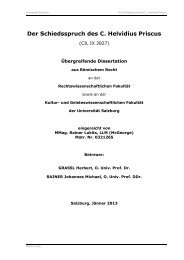(post) Keck Case Law on the Freedom to Provide Services
(post) Keck Case Law on the Freedom to Provide Services
(post) Keck Case Law on the Freedom to Provide Services
You also want an ePaper? Increase the reach of your titles
YUMPU automatically turns print PDFs into web optimized ePapers that Google loves.
does not require such discrimina<strong>to</strong>ry element but is al<strong>on</strong>e sufficient <strong>to</strong> c<strong>on</strong>stitute a measurehaving equivalent effect. Therefore, it could be argued, that <strong>the</strong> Court intenti<strong>on</strong>ally usedthat language of “preventi<strong>on</strong>” <strong>to</strong> establish that a mere “hindrance” of market accesswithout any discrimina<strong>to</strong>ry element does not c<strong>on</strong>stitute a measure having equivalenteffect. C<strong>on</strong>sequently, in <strong>the</strong> case of a n<strong>on</strong>-discrimina<strong>to</strong>ry measure, <strong>on</strong>ly “preventi<strong>on</strong>” in <strong>the</strong>meaning of a ban or a restricti<strong>on</strong> with an equal effect could be c<strong>on</strong>sidered <strong>to</strong> fall under Art34 TFEU. However, in <strong>the</strong> two recent judgments Commissi<strong>on</strong> v. Italy (trailers) andMickelss<strong>on</strong> and Roos <strong>the</strong> Court used a market access test in purely n<strong>on</strong>-discrimina<strong>to</strong>rysituati<strong>on</strong>s. Domestic products were affected by <strong>the</strong> restricti<strong>on</strong>s <strong>on</strong> use in <strong>the</strong> same way asimported products. On <strong>the</strong> surface <strong>the</strong> decisi<strong>on</strong>s did not c<strong>on</strong>cern measures that banned aproduct but mere use restricti<strong>on</strong>s. Moreover, instead of referring <strong>on</strong>ly <strong>to</strong> <strong>the</strong> preventi<strong>on</strong> ofmarket access, <strong>the</strong> court also used <strong>the</strong> term “hindrance” of market access in relati<strong>on</strong> t<strong>on</strong><strong>on</strong>-discrimina<strong>to</strong>ry situati<strong>on</strong>s.I will now discuss how <strong>the</strong>se recent developments in <strong>the</strong> noti<strong>on</strong> of “market access” fit in<strong>to</strong><strong>the</strong> established case law, addressing first <strong>the</strong> specific provisi<strong>on</strong>s regarding use restricti<strong>on</strong>sin <strong>the</strong> two decisi<strong>on</strong>s and <strong>the</strong>n <strong>the</strong> more general questi<strong>on</strong> of what implicati<strong>on</strong>s <strong>the</strong> use of <strong>the</strong>term market “hindrance” instead of “preventi<strong>on</strong>” by <strong>the</strong> Court has.2.2 Recent Developments – Restricti<strong>on</strong>s <strong>on</strong> UseBoth judgments dealt with <strong>the</strong> questi<strong>on</strong> of whe<strong>the</strong>r a restricti<strong>on</strong> <strong>on</strong> use c<strong>on</strong>stitutes ameasure having equivalent effect in <strong>the</strong> sense of Art 34 TFEU. I argue that <strong>the</strong>sejudgments are c<strong>on</strong>sistent with <strong>the</strong> established case law. The restricti<strong>on</strong>s <strong>on</strong> use provisi<strong>on</strong>sc<strong>on</strong>stituted restricti<strong>on</strong>s not because of market hindrance, but because <strong>the</strong>y breached <strong>the</strong>14




